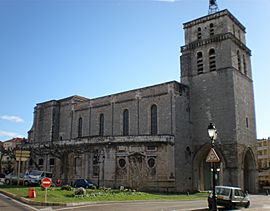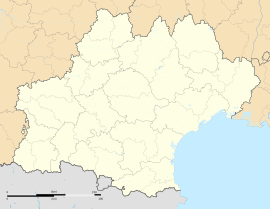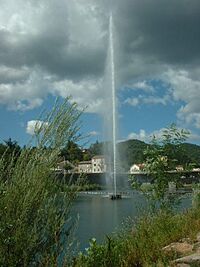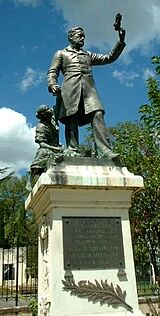Alès facts for kids
Quick facts for kids
Alès
|
||
|---|---|---|
|
Subprefecture and commune
|
||

Alès Cathedral
|
||
|
||
| Country | France | |
| Region | Occitanie | |
| Department | Gard | |
| Arrondissement | Alès | |
| Canton | Alès-1 Alès-2 Alès-3 |
|
| Intercommunality | Alès Agglomération | |
| Area
1
|
23.16 km2 (8.94 sq mi) | |
| Population
(2021)
|
43,892 | |
| • Density | 1,895.2/km2 (4,908.5/sq mi) | |
| Time zone | UTC+01:00 (CET) | |
| • Summer (DST) | UTC+02:00 (CEST) | |
| INSEE/Postal code |
30007 /30100
|
|
| Elevation | 116–356 m (381–1,168 ft) (avg. 150 m or 490 ft) |
|
| 1 French Land Register data, which excludes lakes, ponds, glaciers > 1 km2 (0.386 sq mi or 247 acres) and river estuaries. | ||
Alès (French: [alɛs]) is a city in Southern France. It is a commune and a subprefecture. This means it is an important town and a center for local government. Alès is located in the Gard department, which is part of the Occitania region. Before 1926, the city was officially called Alais.
Contents
Geography of Alès
Alès is about 40 kilometers (25 miles) north-northwest of Nîmes. It sits on the left bank of the Gardon d'Alès river, which almost surrounds the city. The city is at the bottom of the Cévennes mountains. It is also close to the beautiful Cévennes National Park. You can travel to Alès by train, as Alès station connects to cities like Nîmes, Mende, and Clermont-Ferrand.
History of Alès
Alès might be the modern version of an ancient place called Arisitum. Around the year 570, King Sigebert I of Austrasia created a special church area, called a bishopric, in Arisitum. This area included many towns in the northern part of the Cevenne region. These towns were controlled by the Franks, a powerful group at the time. The bishopric of Arisitum stopped existing in the 8th century. Today, the Catholic Church lists Arisitum as a titular see, which is a former bishopric.
After the Edict of Nantes was signed, Alès became one of the safe places for Huguenots. Huguenots were French Protestants who faced challenges for their beliefs. In 1629, King Louis XIII took control of the town. The Peace of Alès was signed on June 29, 1629. This agreement took away some political rights from Protestants. However, it still allowed them to practice their religion freely.
Later, in 1694, Pope Innocent XII created a new church area in Alès. This was done at the request of King Louis XIV. A famous person named Cardinal de Bausset was a bishop in Alès from 1784 to 1790. This church area was closed after the French Revolution. Its territory was then divided between other church areas.
Population of Alès
| Historical population | |||||||||||||||||||||||||||||||||||||||||||||||||||||||||||||||||||||||||||||||||||||||||||||||||||||||||||||||||||
|---|---|---|---|---|---|---|---|---|---|---|---|---|---|---|---|---|---|---|---|---|---|---|---|---|---|---|---|---|---|---|---|---|---|---|---|---|---|---|---|---|---|---|---|---|---|---|---|---|---|---|---|---|---|---|---|---|---|---|---|---|---|---|---|---|---|---|---|---|---|---|---|---|---|---|---|---|---|---|---|---|---|---|---|---|---|---|---|---|---|---|---|---|---|---|---|---|---|---|---|---|---|---|---|---|---|---|---|---|---|---|---|---|---|---|---|
|
|
||||||||||||||||||||||||||||||||||||||||||||||||||||||||||||||||||||||||||||||||||||||||||||||||||||||||||||||||||
| Source: EHESS and INSEE (1968–2020) | |||||||||||||||||||||||||||||||||||||||||||||||||||||||||||||||||||||||||||||||||||||||||||||||||||||||||||||||||||
Economy in Alès
Alès is an important center for mining. It is home to the École des Mines d'Alès, a famous school for mining engineers.
Historically, Alès was a major market for raw silk and cocoons. The Gardon river provided power for many silk factories. The area around Alès also had a lot of coal, iron, zinc, and lead. This led to many jobs in blast-furnaces, foundries, glass-works, and engineering factories.
Sports in Alès
The city has a football (soccer) team called Olympique Alès. They currently play in the Championnat National, which is a French football league.
Sights in Alès
The streets of Alès are wide and have nice promenades. There are also beautiful plane-trees that make the town attractive. The main public buildings include the Saint-Jean-Baptiste cathedral. This is a large building from the 18th century. There is also a citadel, which is an old fortress.
- Parc botanique de la Tour Vieille
Notable People from Alès
Many interesting people have connections to Alès:
- Rigord (around 1150–1209), a writer of history.
- Jean-Pierre des Ours de Mandajors (1679–1747), a historian and writer of plays.
- Jean-Baptiste Dumas (1800–1884), a famous chemist.
- Gabriel Montoya (1868–1914), a Parisian singer.
- Charles Dugas (1885–1957), an archaeologist who studied ancient Greece.
- Edgard de Larminat (1895–1962), a general.
- Louis Leprince-Ringuet (1901–2000), a physicist.
- Lucile Randon (1904–2023), who was once the oldest person in the world.
- Maurice André (1933–2012), a well-known trumpet player.
- Catherine Daufès-Roux (born 1963), a former Member of Parliament.
- Laurent Blanc (born 1965), a famous football player.
- Stéphane Sarrazin (born 1975), a racing car driver.
- Romain Dumas (born 1977), another racing car driver.
- Nabil El Zhar (born 1986), a football player.
- Vincent Abril (born 1995), a racing car driver.
A famous scientist named Louis Pasteur did important research in Alès. He studied diseases that affected silkworms. The town has a statue dedicated to him. There is also a statue of the chemist J.B. Dumas. The writer Alphonse Daudet wrote his novel "Le Petit Chose" while he was teaching at a school in Alès.
Twin Towns – Sister Cities
Alès has a special friendship with another city. This is called being "twinned" or "sister cities".
 Kilmarnock, Scotland, United Kingdom
Kilmarnock, Scotland, United Kingdom
See also
 In Spanish: Alès para niños
In Spanish: Alès para niños






